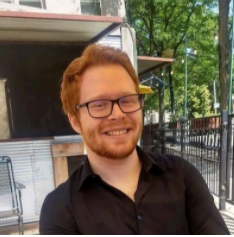Protests come to Wade Lagoon
After the announcement on July 27 that Case Western Reserve University and the Cleveland Clinic would co-host the first presidential debate of 2020 at the new Health Education Campus on Sept. 29, students have been waiting for the day with a mix of emotions, including excitement, anger and fear.
After weeks of wondering whether or not the university would send students home before we ever even made it to the debate, Sept. 29 finally arrived, along with national press, Secret Service agents, armored cars, the National Guard and a protest at Wade Lagoon, just outside of the Cleveland Museum of Art.
Organized by Black Spring CLE, Black Lives Matter Cleveland, the Sunrise Movement, and the Coalition to Stop Inhumanity at the Cuyahoga County Jail, this protest drew a crowd that filled the entire front lawn of the museum. An estimated 500 people attended, including both CWRU students and Cleveland community members, as well as people of all ages and races.
The protest was based around a series of speeches by activists, followed by a march around the University Circle area.
One of the main speakers was LaTonya Goldsby, the president of Black Lives Matter Cleveland and cousin of Tamir Rice, the 12-year-old African-American child who was killed by Cleveland police in 2014. In an interview with The Observer, Goldsby said that it was inspiring to see so many people out at the protest, especially so many young people of diverse backgrounds.
Though Goldsby said that protests have been difficult to organize due the COVID-19 pandemic, her and the other organizers made sure to take safety precautions. This was a special concern for her, as “Black people have been especially in danger” due to COVID-19 disproportionately affecting African-American communities. That being said, she rejected the notion that was often pushed over the summer that protests were responsible for the mass spread of COVID-19. Nearly everyone in attendance wore a mask at all times, and people were encouraged to socially distance when possible.
When asked what she would say to student-protesters who live in the infamous “CWRU bubble,” where many CWRU students are too often disconnected from the realities of people who live in the Greater Cleveland-area, Goldsby said she wanted students to really listen to what the speakers had to say.
“Take the messages in,” she explained. “Share them with friends.”
In a final call to action, Goldsby urged people to “Stand in defense of democracy … Get out and vote. We are obligated [to vote] because of the blood that’s been shed.”
Though many CWRU students declined invitations for interviews, some offered insight into why they were out protesting Tuesday night.
“I’m protesting the current administration and the way Black people are treated,” said one student who wished to remain anonymous. In addition, the student also disapproved of CWRU’s decision to host the debate because it brought so many people to campus, and they did not feel it was safe to do so during the pandemic.
Even so, the student said that it was “empowering to be around all of these people who agree with you and are angry.” They stressed the importance of electing officials committed to reversing the damage done by the current administration, and to continue to push and advocate for more equitable policies in our government.
Other students expressed similar sentiments, with one saying that they were there because they were “unhappy about the debate and the way the nation is going.” Another commented on the reluctance of moderates to acknowledge problems of racism and police brutality, saying that “hopefully the moderate side of the Democratic party will hear what we have to say.”
For first-year history major I’Maya Gibbs, this was her first protest, and she found it “inspiring and empowering.” As a Black woman, she felt proud looking around at all of the non-Black people who were there protesting for racial justice. “This doesn’t just matter to Black people, it matters to all people.”
Gibbs said that, in the early parts of the protest, she was concerned about the safety of herself and her fellow protesters, but that faded away as the night went on. “There’s a difference between a protest and a riot,” she said. That difference was plain to see, as the night remained free of violence.
Speaking about what she wanted to see happen going forward, Gibbs said, “I want to see the campus coming to terms with the racism, police brutality and misogyny that we face.” She wants CWRU to do its part in fighting against injustice.
Calling on her education as a history major, Gibbs explained how this protest fits into the broader history of the never-ending war against injustice: “When there’s injustice, there is always rebellion,” she said. “A lot of protests have changed things,” and she hopes that this protest will prove to be no different.
If you spend most of your free time watching the news or scrolling through Twitter, you may find yourself feeling depressed about the state of the world. But there was none of that depression to be found at the protest on Tuesday. Instead, there was a genuine feeling among the crowd that change was possible and worth fighting for.
The protest officially ended at 8 p.m., at which time there were calls for safety by the organizers. They urged protesters to go home in groups, as they were unable to ensure their safety after the protest was over. There were volunteer marshals present that offered their company to anyone who needed to walk home alone. One major goal of this protest was that there would be no violence and no arrests. The night was successful.

Chris is a fourth-year student majoring in English with minors in creative writing and theater. He does various theater things with Players’ Theatre...

